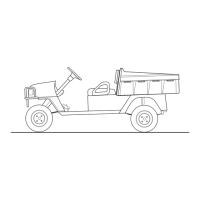GASOLINE UTILITY VEHICLES
Page 15
Owner’s Manual and Service Guide
Read all of manual to become thoroughly familiar with this vehicle. Pay particular attention to all Notes, Cautions and Warnings
Replacing the Fuel Filter
To prevent a possible explo-
sion, do not smoke near the
fuel tank or in an area where
gasoline is being handled. Do not perform procedures
involving the fuel system near open fire or electrical
items which could produce a spark.
Do not handle gasoline in an area that is not ade-
quately ventilated.
Always wear safety glasses to prevent possible eye
injury from gasoline or gasoline vapor.
Using a pair of pliers, squeeze the tabs of the clamps
together and slide them off the filter inlet and outlet. Pull
the fuel filter up higher than the fuel pump to reduce the
amount of gas that may spill. Twist and pull the hose
from the tank off the filter first and plug. Then twist and
pull filter out of the hose from the fuel pump and discard.
Orient direction of new fuel filter according to the
FLOW arrow on the side of filter.
Install new fuel filter and reposition the clamps over the
inlet and outlet.
Checking the Oil Level
Do not overfill engine. Too much oil may
cause smoking and/or allow oil to enter
the air intake system.
The oil should be checked with the engine warm. The
vehicle should be on a level surface with the parking
(PARK) brake locked. Allow adequate time for oil to drain
into the crankcase before checking.
Remove any debris from around the engine oil dipstick
(located behind the air cleaner enclosure) using an air
hose or parts brush (Ref Fig. 23 on page 15). This is nec-
essary to prevent debris from falling into the dipstick hole
when the dipstick is removed.
Remove the dipstick and wipe off the entire area indi-
cated with a lint free cloth (Ref Fig. 24 on page 15).
Insert the dipstick fully into the dipstick hole and remove.
Examine the level of oil on the dipstick.
The engine can be operated safely as long as the oil is
within the safe operating range as indicated on the dip-
stick (Ref Fig. 25 on page 16). DO NOT operate vehicle
if oil level is below the safe area indicated on the dip-
stick.
Oil should be added to bring the level into the safe oper-
ating range. Remember that oil expands as its get hot.
Do not overfill. Check that the oil fill cap is firmly in
place.
Fig. 22 Lubrication Points
Steering
Unit
Ball Joint
on Rack
and Rod
King Pin
King Pin
Idler Arm
! !
Fig. 23 Clean Around Oil Dipstick
Fig. 24 Clean Entire Dipstick

